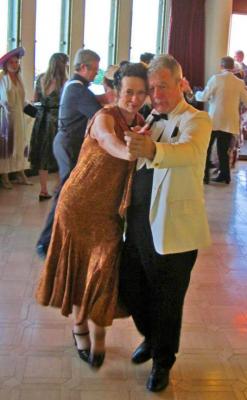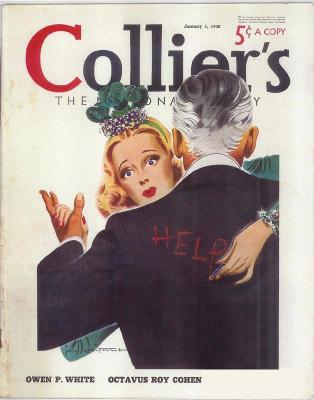- Historical Dance
- Jazz Age Social Dancing ("The Modern Dances")
- 0. The Essentials of Jazz Age Ballroom Dancing
- 1. Foxtrot Part 1: The Jazz Age Foxtrot
- 2. Youth Dancing in the Jazz Age
- 3. The Jazz Age Waltz
- 4. The Jazz Age Tango
- 5. 1930s Rumba
- 6. 1930s Samba
- 7. 1930s Conga
- 8. Bal Musette: Parisian Dance of the Jazz Age
- 9. Dancing in Weimar Berlin
- Dancing Made Easy - 1922
- Film Library - Jazz Age Dance
- Historical Dance Films posted to Pinterest
- Jazz Age Dance - Apologia
- Jazz Age Dance Image Collection
- Jazz Age Lead and Follow
- Places to Dance in Southern California in the Jazz Age
- Sampler of Jazz Age Dance Holds
- The Pathé Historical Dance Collection: 1920s-40s
- Ragtime Dance - the One Step
- Regency Dance
- Victorian Dance
- Jazz Age Social Dancing ("The Modern Dances")
Jazz Age Dance - Apologia
 The initial motivation behind this project, to understand the most popular dances of the "Jazz Age", was frustration and confusion. THE big dance of the time was the Fox Trot, but the Fox Trot as I understood it just didn't seem right.
The initial motivation behind this project, to understand the most popular dances of the "Jazz Age", was frustration and confusion. THE big dance of the time was the Fox Trot, but the Fox Trot as I understood it just didn't seem right.
- The Fox Trot classes I had taken felt complicated and contradictory with seemingly random assortments of "quicks" and "slows" and memorized routines, some of which required me to count (I've never been good at math). It felt like I was getting pieces of a puzzle, without understanding how they fit together.
- The Fox Trot as I understood it and as I saw it performed by trained dancers, looked a bit like Fred and Ginger, but didn't look much like what I saw "regular folks" doing in old movies - and I have always been a bit more interested in regular folks rather than stars
- My Fox Trot wasn't much fun. How could such a dance have been so dominant and universally popular? How was it that this not very appealing dance (as I with my limited understanding understood it) was THE dance of the Jazz Age?
While I am sure there are plenty of folks out there who love the modern Fox Trot, I was not alone in this negative attitude. I once remarked in a blog post that a dance I attended in the Bay Area which had a 20th Century French theme, had a good historical selection except that it lacked Fox Trots (Nuages, La Mer etc.). One of the organizers responded that they left them out because people loved Waltzes and Tangos but no one liked Fox Trots.
Are we moderns so different from the people of the Jazz Age, or are we perhaps missing something?
So, I set about to get to the bottom of it. My academic training is in history, and the first thing I was taught was seek out the "Primary Sources": the documentation from the time in question, unfiltered by the interpretations of third parties. With the dance of the Jazz Age, that was amazingly easy. In the Information Age, old films, where we can see exactly how a dance was danced, are readily available online. Further, the dance manuals of the time are instantly and easily available online and in full text. All I had to do was a bit of Googling, a little reading and a lot of video watching.
What emerged was a sort of dancing that seemed quite different from what I think is generally taught today. I saw a dance that was, at its core, incredibly easy to do (just walking), but which offered a free and unstructured foundation upon which an accomplished dancer could build.
 The first thing I noticed was the way people held each other. This particular detail was generally omitted in the instruction I had received (I only recall it being taught for the Balboa and Argentine Tango), but I came to conclude that it was the essential core of nearly all the dances of the era. For Jazz Age dancers there was no "frame". They embraced each other like teenagers slow-dancing at the prom. This embrace was seen in pretty much every dance but the Rumba and impacted every aspect of the dances.
The first thing I noticed was the way people held each other. This particular detail was generally omitted in the instruction I had received (I only recall it being taught for the Balboa and Argentine Tango), but I came to conclude that it was the essential core of nearly all the dances of the era. For Jazz Age dancers there was no "frame". They embraced each other like teenagers slow-dancing at the prom. This embrace was seen in pretty much every dance but the Rumba and impacted every aspect of the dances.
Another interesting feature was the universality and flexibility of the dance. You could "just walk" to almost any tempo. You could be smooth, romantic and graceful to a slow Fox Trot, or energetic and joyous to an uptempo Jazz number, or seething and passionate to a Tango while still, essentially, doing the same dance - dance that was free and unconstrained. The dancers had absolute permission to do what ever moves they liked, or what ever fancy steps they liked. It was just fine if it seemed like every couple on the floor was doing a completely different dance.
So, eventually, I got it. I finally understood why the dancers of the Jazz Age were so fond of the Fox Trot and how perfectly suited it was to an era of innovation, experimentation and freedom.
I hope that you too, after reading what I have written here and, more to the point, seeing the videos I have posted (such as these), will find Jazz Age ballroom dancing as appealing as I have. Even if you are an experienced and accomplished dancer, who has long ago become expert at more current versions of these dances, I hope you will see in them some elements that you will want to incorporate to add variety and a period flare to your routines.
If you are a beginner, I hope you will see that there is no barrier of complex steps and memorized routines keeping you off the floor.
It's the Jazz Age, and Jazz isn't about rules. It's about freedom, creativity and improvisation.
Get out there and dance!
Walter Nelson
Note: if you are coming into my Jazz Age Dance project at this page, you have arrived more or less at the end. The project begins here: http://www.walternelson.com/dr/1920s-dance
